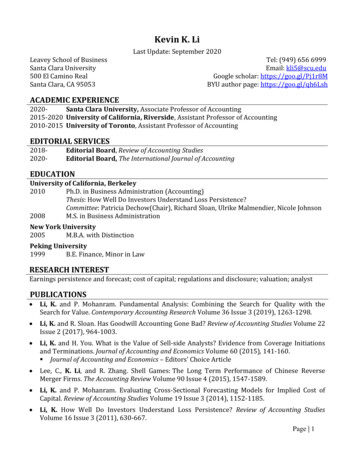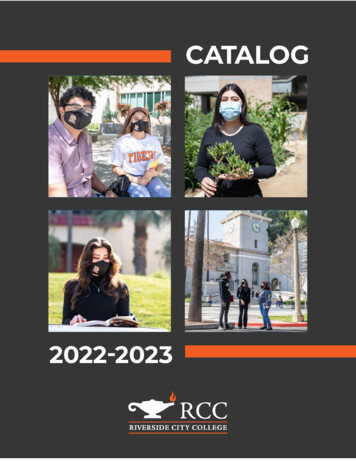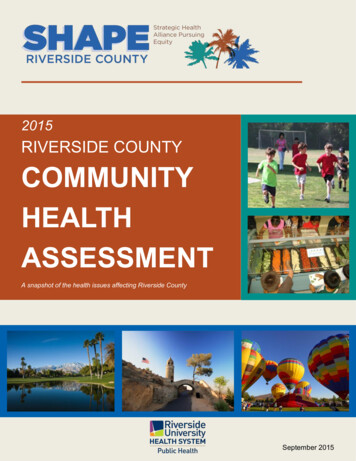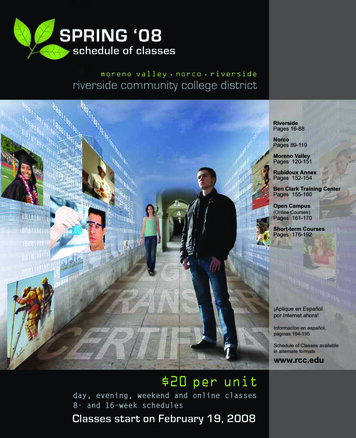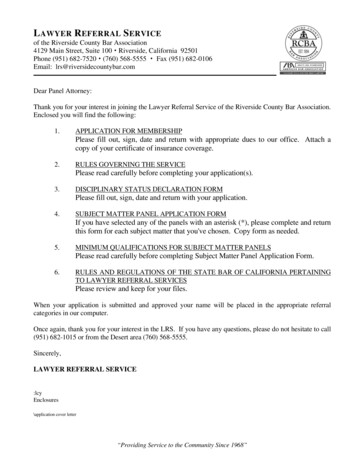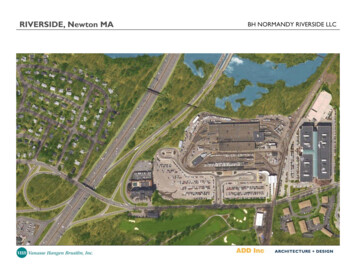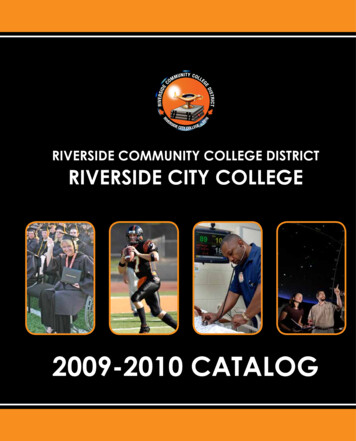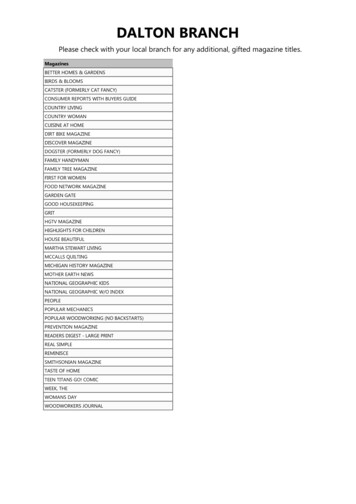
Transcription
Fa l l 2 0 0 6 V o l. 1 N o. 1The magazine of UC riversideReinventingInventionTeaming upAgainst CancerMining the Seasfor Medicine
PublishersWilliam G. BoldtMarcia McQuernManaging EditorKim LaneWritersBetsy BrownRicardo DuranCeleste DurantKim LaneKris LovekinMargene Mastin-ScheppsLitty MathewIqbal PittalwalaBob RuckerLaurie WilliamsContributorsDavid ChangOlivia RiveraE d i t o r i a l A s s i s ta n tKat Sanchezc o n s u lt a n tPeterson Skolnick & DodgeDesignPentagramI l l u s t r at i o n sJohn CraigNancy StahlGary OveracreDugald StermerZach TrenholmPhotographersGabriel L. AcostaLonnie DukaScott MontgomeryBarry RobinsonSteve WalagWebmastersDerk AdamsDawn SaenzGet an MBA from Your UC University of California, RiversideFor the Education You Need, Where You Need ItDistributionBonnie MedianoUCR is published by the Office of Strategic Communications, University ofCalifornia, Riverside and it is distributed free to the University community.Editorial offices: A-140 Highlander Hall, University of California, Riverside,Riverside, CA 92521, telephone (951) 827-6397. Unless otherwise indicated,text may be reprinted without permission. Please credit UCR, University ofCalifornia, Riverside.UCR ISSN (1056-4276) is published four times a year: Winter, Spring, Summerand Fall by the University of California, Riverside, Riverside, CA 92521-0155.Periodicals postage rates paid at Riverside, CA.POSTMASTER: Send address changes to UCR, Subscription Services (0063),A-252 Highlander Hall, Riverside, CA 92521-0149.In accordance with applicable federal laws and University policy, the Universityof California does not discriminate in any of its policies, procedures or practiceson the basis of race, color, national origin, sex, sexual orientation, age, orhandicap. Inquiries regarding the University’s equal opportunity policies may bedirected to the Affirmative Action Office, (951) 827-5604.Study with quality facultywho are at the top of their fieldsin such areas as: E-Commerce Marketing Intellectual Property Management EntrepreneurshipGet an MBA in a program that: Is AACSB accredited Features a wide selection ofcourse offerings Tailors coursework to yourneeds through class size andaccessible faculty Offers opportunities to learnfrom today’s successful CEOs atthe new UCR Palm DesertHeckmann CenterContact us:www.agsm.ucr.edu951.827.6200mba@ucr.edu
T h em a g a z i n eo fU Cr i v e r s i d eFall2006Volume 1Number 1Departments03R ViewReinvention —a message fromChancellor Córdova.04R SpaceA quick look at what’shappening at UCR.20F e at u r e sPage Turners18Teaming UpAgainst CancerFrom high-end cancercell research to attending basketball practice29with their two sons,engineering professorsGiftedCengiz and Mihri OzkanDonor Mark Schroederfind that collaborationon why he stays— and a lot of multitasking — makes it work.connected to UCR.2430How I See ItMining the Seasfor MedicineUCR graduate WilliamFenical is makingwaves — he searches theocean floor to find freshand innovative sourcesA UCR professor sharesher experience of scoring08Reinventing Inventionfor medicinal cures.Change, they say, is good. But in this world of turn-on-a-dime28technology and continuous global modernization, the abilityIs it Art, or Chemistry?to constantly rework, transform and retool can be a matter ofVincent Lavallo’s work insurvival. In this issue, we ask three UCR innovators to discusschemistry is an art.what reinvention is, why it’s important and where it can lead.a film in 48 hours.31Gathering40C ScapeA UCR Highlanderwho is passionate aboutgolf and politics.UCR Fall 2006
v i e weventsrReinventionat its BestMusic, Dance, Theaterand MoreFor more on UCR events, look on the Web at www.events.ucr.edu.Welcome to UCR magazine (previously calledWithin these pages, you will learn moreFiat Lux magazine). In keeping with the spiritabout how UCR is also transforming the worldof the reinvented and reinvigorated look andin which you live. From the development offeel of this publication, designed to showcasealternative fuels to the creation of drought-11.2901.25 –27, 02.01– 03 1.31 – 3.7the insights, innovations and impacts of ourresistant crops to the invention of newcampus community, I invite you to explore withnanotechnologies for medicine, our scientists,Noche FlamencaOne Size Fits AllThe Road to Oscarus the art and science of reinvention.engineers and researchers are improving theKnown for its passion and dedication toThis play by Assistant Professor of TheatreOffered through the Osher Lifelongthe integrity of the flamenco, the danceRickerby Hinds explores the exploitation ofLearning Institute, which is open to thoseheart of the education process itself, from theeven as they educate our next generation ofcompany Noche Flamenca will perform inchildren around the world through four50 years and older, this course looks atopportunity to explore their individual gifts toinnovators, ethicists and entrepreneurial leaders.the University Theatre.children’s quests to find the life embodiedpast and present Academy Awards as athe experience of discovering, acquiring andin a pair of sneakers.means to better understand filmmakingapplying new knowledge. So, too, the lifereinvention as a continual process of rebirthand the creative process.cycle of a university is a study in reinvention,and renewal, one in which our alumni andas hundreds of talented, eager young socialfriends play a key role. This fall, I have beenvisionaries and scientific detectives pass throughprivileged to meet with dedicated, accom-our halls of learning and into the worldplished UCR alumni from all over the countrybeyond. This year, the campus welcomedand to share with them our vision for the future4,429 new Highlanders, raising the size of ourof UCR. It is a shared dream, made possiblepopulation to 16,875 students.only by the continued involvement ion.ucr.edu/olli12.09E V EN T S IC ONSHoliday Choral Music01.27 – 03.17The UCR choruses and the UCR BrassEmpire.Style2.14, 2.15ensemble, conducted by G. Edward BrunerEmpire.Style, curated by Peter Zellner,100th Anniversary Celebrationand Ruth Charloff, come together tofeatures works that explore the socialThe UCR Citrus Research Center andperform Pinkham’s Christmas Cantata.and economic energy of the AmericanAgricultural Experiment Station celebratessuburbs, and the move of cultural activityits 100th anniversary with a banquet onfrom city to suburb.Feb. 14 and a symposium on Feb. 15.sweeney.ucr.eduwww.cnas.ucr.edumusic.ucr.eduFor our students, reinvention lies at theThanks to the generosity of our supporters,quality of life for millions around the globe,Finally, it is important to recognizecontributions of all members of our extendedUCR is reaping the benefits of a record-breakingcampus family. I look forward to working with 40 million fund-raising year, enabling theyou to make it a reality.campus to reinvent itself in ways both intellectual and physical. This year, we were pleased toadd nearly 50 outstanding scholars andSincerely,researchers to the ranks of our distinguishedfaculty. And, as highlighted by the recentgroundbreaking for a new state-of-the-artgenomics research building and the anticipated01.17Author Seriesopenings next year of the CHASS Instructionand Research Building and the Alumni andAssistant professor Margaret Nash,01.28 – 04.1403.08 – 10recipient of the 2005 Critics ChoiceLiset Castillo: Lakewood, Calif.UCR is Dancing 2007Book Award of the American EducationalCastillo’s large-scale photographs ofThis annual production is the culminationStudies Association, will speak on herhighways and intersections are derived fromof five quarters of instruction and featuresbook “Women’s Education in the Unitedsand-castle models. This series is based onoriginal choreography by UCR studentsStates, 1780–1840,” which examines theone of America’s first planned communities,that demonstrates new ideas and experi-underlying rationale for educating women.Lakewood, Calif.mentation in isitors Center, as well as the expansion ofthe East Campus Child Development Center tobegin in 2008, the campus is rapidly evolvingto meet the demands for more classrooms, labs,child care and housing space. Through thedevelopment of plans for a new medical school,and with efforts well under way to expandthe reach of other professional schools, UCRhas positioned itself to meet the workforce challenges of 21st century Inland SouthernCalifornia and beyond. UCR Fall 2006ChancellorFrance A. Córdova“It is importantto recognizereinvention as acontinual processof rebirth andrenewal, one inwhich our alumniand friends playa key role.”
environmental research; a 1.5 million gift for an endowed chair for teaching innovation;Ratings Boost a 1 million gift for an endowed chair in cancer research;Guide doesn’t use SAT scores and grade point averages toNew PrivateFund-RaisingRecordevaluate schools. Instead, its reviewers ask qualitative questions,UCR raised a record 40.1 million in private gifts and pledges insuch as “What is this college doing for the country?” “Is this2005–06, more than doubling the amount raised in 2004–05.Washington Monthly College Guide has ranked UC RiversideNo. 22 among universities and colleges in the United States.Unlike most college ratings guides, Washington Monthly Collegecollege an engine of social mobility?” and “Does this schoolfoster scientific and humanistic research?”UCR’s ranking rose more than any other school’s relative toits U.S. News & World Report ranking.“We’ve always felt that our mission — carried out throughclassroom instruction, scientific and humanistic researchand community outreach — has been to make a significantcontribution to the people of California,” a 1 million gift from the Gluck Foundation for arts outreach;New UC Regent is from Inland EmpireAfter more than four years without a 1 million grant from the Bernard Osher Foundation for arepresentation on the UC Board of Regents, thelearning program for seniors;Inland Empire once again has an ambassador a 1 million pledge from Ron and Margaret Redmond to finishon the board. Bruce Varner, a partner in thethe Alumni and Visitors Center;The fund-raising effort was given a substantial boost in June,when Bart and Barbara Singletary and William and Toby Austintogether contributed 16.5 million in two charitable trusts forRiverside law firm of Varner & Brandt LLP, a 500,000 gift from the estate of Rosalie Ketchersid forwas appointed by Gov. Arnold Schwarzeneggerscholarships; a record 450,000 total for the UCR Fund, an annualtelephone campaign to alumni; a 240,000 gift from California Wellness to support thein August. His term began with the regents’ Sept. 19 meetingin San Francisco.The 69-year-old attorney joins 25 other board members whothe support of endowed professorships in the social sciences, theFastStart program for students interested in health care careersmake policy for the UC system. In addition to the governor, otherlaw, public policy, agriculture and medicine.serving the underserved.public and university officials and one student, Varner joins 17Other recent gifts to UCR include:“That we’ve accomplished so much so quickly speaks volumes a 1.6 million grant from the Howard Hughes MedicalInstitute for biomedical student preparation;about the generosity of UCR’s supporters,” says Associate Viceother public members appointed to 12-year terms. Regentsreceive no salary for their service.Chancellor for Development Susan Harlow.says UCR Chancellor France Córdova.“It’s gratifying to see that effortrecognized nationally.”New GolfScholarshipDonald and Anne Skotty haveestablished the William G.Skotty Endowed Golf Fund tosupport golf scholarships forUCR students. The SkottyFund will provide a four-yearBeijing Center Offers TEFL ProgramUCR’s International Education Programs is partnering withthe Yale-China Association to offer the first-ever Yale-ChinaTeaching English as a Foreign Language (TEFL) program atUCR-Beijing International Education Center. Seven Yale-Chinafellows have begun TEFL training at the center.International Education Programs has offered a range ofprograms since opening the center in October 2005,including targeted conversationprograms that will help addressChina’s need for English speakersduring the 2008 Olympics and asthe country increasingly doesbusiness with the West. UCR Fall 2006 1 1million for a Biom .6 m 1.5 million foriLearning Program ed S lliontu fo Environmentalfor Seniorsde r Researchnts Bi 1.6om me ill 1million ford S iontfArts Outreach uden orts 1.5In milin nov lionTe at foac ion rhingR space a 1.5 million grant from the W.M. Keck Foundation forscholarship for one member ofUCR’s men’s or women’s golfteam, with the scholarshipsalternating every four yearsbetween the two teams.Donald Skotty’s uncleWilliam was a World War IIveteran whose passion for golfwas kindled with weeklyminiature golf outings inLos Angeles. He was marriedto former UCR employeePatricia Skotty, an activemember of the UCR Retirees’Association. William Scottypassed away in January.UCR Fall 2006
A 2005 UC report found that nearly one-third of California’sUnitedHealth Group has donated 5 million to UCR for thethree EPA scientists, Venkatram and Princevac demonstrated theK-12 teachers expect to retire by 2015, a high proportion ofcreation of medical education and related health sciencesConscientiousnessa BetterPredictor thanSATs Aloneuse of an EPA-developed air-quality modeling system for theirProfessors HelpClear the Air in IndiaAkula Venkatram and Marko Princevac, UCR mechanical engineer-ing professors, recently traveled to India as part of a U.S.Environmental Protection Agency (EPA) effort to aid in development of an urban air-quality management system. Along withTrainingTomorrow’s Teachersin CaliforniaMed SchoolFunding Gets aBooster Shotthem math and science instructors. That’s why eight UC systemprograms — giving a significant boost to UCR’s campaign for aIn a recent paper, Seth Wagerman, a UCR doctoral candidate inIndian colleagues. Venkatram played a key role in developing thecampuses, including UCR, created a program called theschool of medicine.psychology, and psychology department Chair David Fundersystem, called AERMOD, while Princevac provided training onCalifornia Teach Science-Mathematics Initiative. The initiativethe system’s instruments.partners the UC campuses with the California State Universitythat called for creation of new comprehensive medical educationstudent’s work ethic and self-discipline than to intelligence orsystem in recruiting student participants into a four-yearprograms by 2020 in medically underserved regions, such astest-taking ability.program, then tracking their progress — through an internInland Southern California.India’s rapid economic and industrial development hasspawned pollution problems that are among the world’s worstand are thought to contribute to 3 million premature deaths andincreasingly severemonsoons.“We hope thispilot program willattract the attentionteaching credential to full credentialing after graduation.The contribution is a response to an April 2005 UC study“This generous gift has created a strong foundation for ourfound that success in college corresponds more closely to aIn the study, acquaintances and trained clinicians describedstudents’ personal qualities and compared them with thehealth sciences initiative and provided momentum for ourstudent’s grades and SAT scores. “Being described by others asother UC campuses, students identify career paths in teaching,campus to attract other gifts from foundations, corporations andconscientious and hard-working predicted college gradescultivate strong professional connections and mentors, andindividuals,” says Chancellor France Córdova.years down the line,” Wagerman says. “Highly motivated andAt UCR’s SMI Resource Center and its counterparts at thedesign advising paths.The program also provides stipends for educationUCR will use the funds to hire faculty and staff to establishorganized students who are determined to succeed are likelycoursework associated with the campus’sto do well, regardless of their SAT scores.” The findingsof the World Bank,coursework and fieldwork in elementary and secondary schoolhealth sciences program, upgradestrengthen an argument that SAT college entrance exams shouldwhich could step inclassrooms. Students learn firsthand how education theoryresearch and educational facilities, andcarry less weight in college admissions.and offer ongoingand subject knowledge can best be applied in the classroom.expand planning for the health sciencessupport to theInitiative organizers hope to attract as many as 5,000 UCIndian govern-and community college students into the program with 1,000ment,” saysinternships in California secondary schools.initiative that the university launchedlast year.Venkatram.Focus of Research on Evolution/Ecology InteractionUCR Evolutionary biologist David Reznick is leading a team ofNew Leader for CHASSStephen E. Cullenberg, an economics professor at UCR since1988, has been appointed dean of the College of Humanities,Arts and Social Sciences (CHASS).Cullenberg replaces Joel Martin, a historian who served asinterim dean for two years (before he was hired recently as deanat the University of Massachusetts, Amherst).researchers that received a five-year, 5 million National ScienceFoundation grant to find the answer.Joined in the effort by colleagues from U.S. and CanadianSAT ScoreWORK ethicuniversities, Reznick will study the evolution/ecology interactionsin natural stream communities on the island of Trinidad.The team will focus on guppies — small fresh-water fish —that coexist in the stream with the Hart’s killifish, a predator.The team will examine what causes the guppies to evolveas they might and also the coevolutionof the killifish. UCR Fall 2006UCR Fall 2006
Reinvention“Discover and innovate” is the mantra of thethe darkest nights of the soul? Is it amodern American research university. Butserendipitous event or, quite simply, essentialwhat does it mean to discover in an era whento human survival? In this issue of UCR weour final frontiers are not defined by mereasked three UCR innovators to weigh in ongeography? And whence comes the drive tothe concept of reinvention. Their musingsinnovate? Is it in our DNA or simply our culturalreveal that reinvention is older than Darwin,destiny? Is it catalyzed by the quintessentialas American as apple pie and as familiar as“a-ha!” moment or does itthe human quest for happiness. By Betsy Browngrow fromReinventing Invention
the bootstraps into better circumstances,sourced other functions, such as manufac-oby Miller has been a CalifornianMiller sees manifestations beyond theturing, to countries that can perform themfor only two years, but he’s beenindividual entrepreneur. “The forces ofmore competitively.” Witness California:a California dreamer all his life.reinvention have less to do with individualan agrarian paradise in the early 20th“Growing up in Australia, Iinitiative than with deeper cultural andcentury, reinvented as industrial-militaryharbored a California fantasysocioeconomic forces — and with howMecca in World War II, evolved duringbased on perceptions of the state’s naturalsocieties interact with each other on theand since the Cold War into a touristbeauty, the lure of Hollywood, the impactworld stage,” he says.haven, a high-tech incubator and aof the American military,” says Miller,As an example, Miller cites theHollywood dream factory, perpetuatingprofessor of English, sociology andreinvention of the American work forcethe myth of America as reinvention capitalwomen’s studies in UCR’s College ofover the past 100-plus years, as regions ofof the world.Humanities, Arts and Social Sciences.the country — in the grips of first theEven more interesting, Miller pointsindustrial, then the technological revolu-out, California’s self-reinvention as a high-well-articulated opinion on all thingstion — evolved from an agrarian to antech haven illustrates the dangers thatsociocultural — media, sports, labor,industrial to a service-industry base. “Asbefall a society when it allows itself to takegender, race, citizenship, politics, econom-first-world countries like the United Statesinnovation for granted as the exclusiveics — Miller understands the importancehave evolved toward service-baseddomain of the individual entrepreneur.of reinvention to the American mindset ineconomies, increasingly, they’ve out-“Continued innovation requires a combi-A big-idea generator with a ready and“Reinvention is the founding mythology of AmericanBreathing New Life into AnimationThe characters in computer games and animated films may wowus with their verisimilitude. But look closely: Are those charac-culture. This is a nationters really breathing?based on the idea that youBreathing, from an animator’s perspective, is hard to capture.There’s a reason the answer to that question is usually no.“Breath combines the rigid movement of bones with the deformable movement of musclescan come here fromand other tissues, which is irregular and complex,” says Victor Zordan, an assistant professoranywhere in the world overlook breathing because the subtlety required to animate it isn’t worth the overhead.”and reinvent yourself.”— Toby Millerin the Department of Computer Science and Engineering at UCR. “Animators oftenZordan, who founded the Riverside Graphics Lab, was determined to change allthat. Studying anatomy, physiology and film of human motion — using physics, computation and pure intuition — he and his research students developed a believable, threedimensional motion model of human breathing. And they did it by reinventing thefamiliar. “We applied simple, well-known animation techniques — the kind used to showgeneral and California in particular.“Reinvention is the foundingmythology of American culture,” he says.movement in cloth in games and movies — in a novel way to model a hybrid rigid/deformable torso capable of respiration.”But repurposing tried-and-true techniques wasn’t the only innovation to grow from“This is a nation based on the idea thatZordan’s work. Trolling the Internet, Steve McCall, a medical educator from Blue Cross/you can come here from anywhere in theBlue Shield in Hawaii, came across Zordan’s Web site and found what he’d been lookingworld, transcend class, race, gender andfor: video demonstrations of computer-animated humans breathing. Collaborating withfinancial circumstances and reinventMcCall, Zordan developed a software program called Breathe Easy. McCall now uses theyourself.” This concept comes to life inprogram in his stress-reduction classes to demonstrate deep-breathing techniquesCalifornia — a Western American “questdeveloped by a Harvard cardiologist in the 1970s.destination” for people from around theWhen it comes to what animation can bring to healthcare education, Breathe Easyworld — and in the Inland Empire,is just the beginning. “I see many applications in the modeling of other complexfastest-growing region in the country.physiological processes, such as swallowing and digestion,” says Zordan. View Zordan’sAlthough Miller’s notion is perhapsmost familiarly illustrated in the works ofHoratio Alger Jr., in which the hardknocks American hero lifts himself up by10 UCR Fall 2006work at www.cs.ucr.edu/%7Evbz.ToBy MillerTCalifornia Dreamer
N o rm E l l st r andnation of public and private investment,”about more than just teaching classes —says Miller. “Looking at the high-techthat they contribute to the local culture andsector, we’ve had investment by businesseseconomy, that they undertake research, thatand the military — a big driver in thethey are engines of reinvention.”initial development of the Internet. ButAt risk, Miller points out, is morepublic investment has lagged.” As a result,than any one person’s opportunity toMiller says, the United States has nowlevitate into the lap of high-tech luxury.fallen behind in the proliferation of and ac-“Although the Horatio Alger mythologycess to technological innovation, “as welives on in our collective imaginations, ithave with access to health care. To makedoes not reflect life in American societythe most of innovation, we need to connectanymore,” he says. “There are otherpublic and private sectors.”places where it’s much easier to liftWhat happens to a society that failsyourself out of poverty and reinvent your“Reinvention goes on allthe time in nature It’snever perfect, and it’s neverfinished. No sooner doesan organism adapt to itsenvironment than the environment changes again to make the connection? “It loses itsfuture — Britain, Spain, Italy.” Theequity in the innovation,” Miller says.solution, Miller believes, lies in the“Ordinary people can’t access it.” Case inreallocation of resources, whether wealth,point: although information technologytechnology or simple opportunity, for thehas proliferated in the past 25 years,public good — an act of reinventionaccess to it has not kept pace, resulting inperhaps not unlike the quest for a moreadvantage were ‘designed’ for a differenta society increasingly stratified into tech-universally accessible good life that firstpurpose,” Ellstrand says.haves and tech-have-nots. “The Internetinspired immigration to the Golden State.isn’t funded the way radio and TV were in“As Californians, we must reinventevolution of insect wings: research revealstheir early days. High cable and telephoneourselves as a multicultural society andthat they actually began as tiny bumps onbills now restrict access to high-techrestore the greatness that is California’sthe insect’s back. Insects with these tinyservices and disenfranchise large segmentspublic sector.”bumps found themselves with an evolu-of the population,” Miller says.Then there’s the aftermath ofinnovation and reinvention: what happenswhen today’s technology breakthroughsgive way to tomorrow’s whiz-banggizmos? The consequences are daunting,Miller points out — enough to makereinvention of what we do with techno-TWe’re always catching up.”— Norm EllstrandAs an example, he offers up thetionary edge — the additional surface areaIt’s Only Naturalthey provide helped with thermoregula-alk to most scientists abouttion, enabling bump-endowed bugs toreinvention manifested in thewarm and cool their bodies more effec-natural world and you won’t heartively. If little bumps provided a slightmany mentions of supermodelsedge, larger bumps provided an evenor the architectural marvels ofbigger advantage until, over generationsmedieval cathedrals. For such interdisci-and generations, the bumps elongatedplinary interconnections, seek the counseluntil they became long appendages thatogy is supposedly a clean economy, but itsof Norm Ellstrand, a geneticist and profes-enabled the insect to glide. Voila: flight.pollution is a threat we don’t understand,”sor of genetics at UCR and director of theSometimes the same principle ofhe says, citing the growing number ofuniversity’s Biotechnology Impacts Center.accidental enhancement finds expressionwaste a must for our survival. “Technol-high-tech dumping grounds across the“Reinvention goes on all the time inin the realm of human endeavor. StevenWestern United States, where youngnature,” Ellstrand says. “It’s never perfect,Gould and Richard Lewontin noted thepeople who probably can’t afford theand it’s never finished. No sooner does anspandrels in medieval San Marco Cathedraltechnology they’re dismantling do the techorganism adapt to its environment thanin Venice. “These gorgeous architecturalindustry’s dirty work.the environment changes again —features were really just weird corner bitssometimes in response to the organismin the places where two arches meet,”itself. We’re always catching up.”Ellstrand says. “There was no great planSolutions to this and other postinnovation dilemmas — from air and waterpollution to traffic congestion — mustAlthough humans often perceiveto invent these cool spaces, just cleveremerge from modern American researchreinvention as an act of will — foruse of architectural leftovers.” Theuniversities like UCR. “I see UCR as ainstance, we choose to make somethingevolutionary metaphor, Ellstrand says, isboutique: flexible, nimble, open, providingbetter — in reality, reinvention is a naturalthat sometimes key adaptive features areideas and people, inspiring investment andforce as often accidental as it is purpose-just an evolutionary exploitation of junk.partnership in the region,” he says.ful. “Many of the features that provide“Universities need to show that they arecreatures and plants with an evolutionaryPerhaps an even more intriguingexample of reinvention is the redefinitionUCR Fall 2006 13
should be humble. “The knowledgeof “non-Darwinian” forces. “Darwinwe were certain of 50 years ago, overmentions genetic variation throughtime, has been revealed as imperfect —mutation, but his emphasis was on naturaljust as today’s knowledge will be 50selection,” Ellstrand points out. “Heyears from now.”didn’t take into account chance events likeWGo Ahead and Laughhat’s the simplest act ofreinvention — one any ofus can commit, any time,any day, any place? ToThank goodness for the naturalmigration and genetic drift, which haveforces of reinvention — the constantgained credence over the past 50 years.”striving for illusory perfection, towardMutation through genetic drift andwhich Ellstrand takes a Zen approach.Sonja Lyubomirsky,professor of psychology at UCR, it’sprobably smiling. Or maybe laughing.Perhaps a small act of altruism.another reinventive concept, genetic“Perfection is in the eye of the beholder,engineering, are Ellstrand’s areas ofand it is much more than we can see withunderstanding how people can reinventexpertise. When the genes of herbicide-our scientific eye at any given time,” he
Riverside, CA 92521, telephone (951) 827-6397. Unless otherwise indicated, text may be reprinted without permission. Please credit UCR, University of California, Riverside. UCR ISSN (1056-4276) is published four times a year: Winter, Spring, Summer and Fall by the University of California, Riverside, Riverside, CA 92521-0155.


